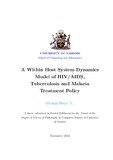| dc.description.abstract | Simulation and Modelling have a good history of application in numerous decision
support health cases where the objective is of a managerial or policy nature. In-
formation and Communication Technologies(ICT) in health care decision support
with the application of simulation methods is receiving attention as indisputable
advantages of these methods are getting widely recognized. Cutting edge eHealth
researches have led to signi cant technological achievement, covering an expan-
sive range of health services. Understanding the dynamics of disease is of crucial
importance particularly in terms of risk assessment and evaluation of intervention
policies against a large-scale epidemic outbreak. However most of the information
is available after the spread itself, and preemptive assessment is far from vital.
Chronic diseases such as HIV, TB and Malaria e.tc. are widely studied and mod-
elled. Apparently the researches carried out have been on the pathogenesis of
the diseases individually i.e. HIV alone, TB alone and Malaria alone. Others
researches have focussed on HIV and TB or HIV and Malaria but none has gone
beyond trio infections which is quite common. With the advent of HIV, PLHIV
are more prone to cofactors with the resultant of immune activation. Immune ac-
tivation leads to the increase of HIV viruses as a result of bursting of resting TH1
cells once they are activated since HIV resides in resting TH1. This research aimed
at studying immune activation for people living with HIV when they are attacked
by other diseases like TB and Malaria which is quite common. The research was
bordering on cells of the immune system that conduct adaptive immunity.
Immune system is quite complex to understand even so when the system is attacked
by pathogens. As such, System Dynamics Modelling was applied to improve the
understanding of immune system behaviour for people living with HIV in light of
Malaria and TB. To understand the full range of immune cells and their activities,
behaviour of pathogens and communication of immune cells to resist attack, eld
studies were carried out. Problems associated with the immune system inability
to curb pathogens as a result of immune activation, how the HIV virus takes
advantage of activated cells through attack by mycobacterium and merozoites were
sought after in the eld studies. The Research presents the overall architecture
of the HTM system which constitutes cells, agents of the immune system like
interleukins, interferons, natural killer cells as well as information
ow. Qualitative
research was done using causal loop diagrams as well as simulation through stock
and
ow diagram to capture the complex and dynamic nature of the immune
system. The use of CLD provided deeper understanding of the structure of the cells
of the immune system while simulation through stock and
ow diagram provided
the dynamic behaviour of the same.
The results of the study show that activation of the immune system by TB and
Malaria for people living with HIV have overwhelming in
uence in their health.
The study rea rms the need to maintain rested TH1 cells, as wells develop policies
or regimens to deal with synergistic activities of TB and Malaria to PLHIV. The
developed HTM system demonstrates the dynamics arising from the complexity,
delays and non-linearlity which characterize the immune system. Based on the
results of the simulations experiments, the suggested intervention that could im-
prove the lives of PLHIV include the following: designing of relevant health IS,
strengthening of healthcare system, adoption of ICTs innovations to improve e -
ciency and improving literacy levels.
The HTM model and the causal loop diagrams presents signi cant knowledge in
terms of structure and the understanding of HTM system. The model captures
requisite information requirements, key activities of the immune cells which repre-
sents the adaptive nature or collapse of the immune system. The model provides
tools that tests di erent policies thus making it useful for strategic planning and
policy debate. | en_US |



